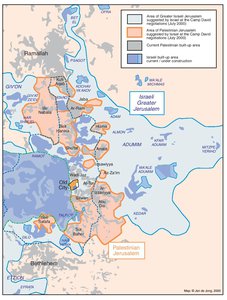PROJECTION OF THE ISRAELI PROPOSAL FOR JERUSALEM’S FINAL STATUS AT CAMP DAVID, JULY 2000
Map Details
Just prior to entering the Camp David final status talks of July 2000, Israeli Prime Minister Barak reiterated
his government’s position on Jerusalem, saying: “Jerusalem will not be divided, we will protect the Holiness
of Israel.” By insisting on negotiating in line with Netanyahu’s latest ‘Greater Jerusalem’ vision, Barak
extended Israel’s claims beyond unilaterally annexed East Jerusalem and deep into the West Bank
hinterland, endowing distant settlements beyond Ramallah, Jericho and Bethlehem with the “Holiness of
Israel.” The tactic was in part a vehicle for cutting the heart out of the West Bank under the guise of claims
to an “undivided eternal capital.” In this sense, it served to camouflage Israel’s most vulgar attempt at
expansionism amid the complexities of the isolated and postponed Jerusalem negotiations. But insistence
on negotiating a newly redrawn and greatly expanded ‘Jerusalem’ also allowed Israel to obfuscate its bid to
legitimize total sovereignty over the city by placing Palestinian towns deep in the West Bank within the
imaginary bounds of the city and then ‘generously’ ceding them to the Palestinians as though they were a part
of the occupied city.
In actuality, the maps relating Israel’s proposals at Camp David placed virtually the entire area of pre-1967
Arab East Jerusalem under exclusive Israeli sovereignty and compelled the Palestinians to negotiate
sovereignty over villages and towns on the periphery of the municipal area. With Palestinian objection to the
annexation of Bet El or Mitzpe Yericho portrayed as an attack on the “Holiness of Israel,” Barak’s
negotiating team was easily able to label fundamental Palestinian demands for sovereignty over the Old
City and Al-Haram Ash-Sharif, obstinate and impossible “dreaming.” The US endorsed Israel’s opening
positions on the city and during the negotiations more than once ‘repackaged’ them to present as their own,
prompting the Palestinians to cry foul a number of times.
Having succeeded in redefining the city, Israel went on to redefine ‘sovereignty.’ Again gaining US
endorsement, Barak’s team proposed the Palestinians be granted “administrative control” in East Jerusalem
neighborhoods near and around the Old City. This was followed by an ‘offer’ of “local safe passage” to Al-
Haram Ash-Sharif and talk of a “special regime” to operate within the Old City. The principal holy site itself
was then subjected to a series of US-Israeli scenarios, drawing on notions of “vertical sovereignty,” “residual
sovereignty,” municipal,” and “custodial” autonomy… Each of these permutations was presented as an
expression of Israel’s historic generosity; each denied absolutely any true form of Palestinian sovereignty
over the holy sites, the Old City, or the neighborhoods surrounding it; each legitimized Israeli sovereignty
over occupied and expanded East Jerusalem.
The US repeatedly praised the “particular courage, wisdom and understanding” of these concoctions and
thereby reinforced Israel’s contention that it had presented its ultimate concession on the city and in doing
so had satisfied the expectations of Oslo’s ‘honest brokers.’ In fact, Israel’s ‘generosity’ on Jerusalem came
at a price; Barak demanded his ‘concessions’ be repaid with Palestinian acceptance of Israel’s right to erect
a synagogue within the Haram Ash-Sharif – the sanctuary of Islam’s third holiest site. Preposterous though
the idea was, it was presented at a stage when the talks already seemed doomed and was delivered in all
seriousness. The US immediately internalized Israel’s demand and pushed the Palestinian negotiators to
accept it, assuring them they could always “limit the number of Jews who pray…”
Palestinian rejection of the proposal – which was never developed into a comprehensive and detailed
formula – was not only due to Israeli insistence on sovereignty over the Old City and Al-Haram Ash-Sharif.
The proposal on Jerusalem transformed an enormous illegal settlement program to the east, north and
south of the occupied city into a recognized sovereign Israeli barrier, bisecting the West Bank at its historic
heart. Within this area, Palestinian villages – such as Jaba and Az-Za’im – were to be forever
encapsulated by Israel’s settlements, while those afforded contiguity with the Palestinian state were to be
divested of much of their land and their access to the city itself. The myriad ‘administrative’ and ‘regime’
sectors proposed in lieu of granting Palestinian sovereignty in the city paved the way for Israel to impose
further social, legal and cultural sub-divisions upon the Palestinian people.
In sum, the Jerusalem proposal made at Camp David gave the Palestinians an unviable series of isolated
population clusters, while denying them any substantial sovereignty in the city itself and creating an Israeli
sovereign bloc from Jericho to Ramallah and Bethlehem, with occupied Arab East Jerusalem at its heart.
Israel’s ability to present such a proposal, to term it a concession, and even to be praised for doing so,
rested entirely upon its 33 years of condemned illegal settlement activity within and around the city. Warm
endorsement of Israel’s offer by the US and much of the international community rewarded the concerted
settlement activities of successive Israeli governments and reinforced Israel’s conviction that through the
creation of facts on the ground it could not only thwart Palestinian aspirations and deny Palestinian rights,
but be saluted for doing so.
Related Maps
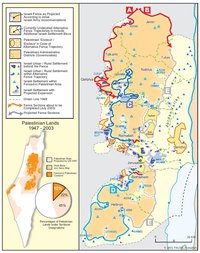
ISRAEL'S SEPARATION BARRIER, 2002
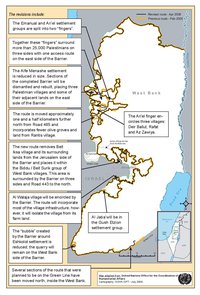
REVISED ROUTE OF THE ISRAELI SEPARATION BARRIER, 2006
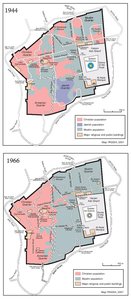
THE OLD CITY, 1944 & 1966

MUNICIPAL BOUNDARIES OF JERUSALEM, 1947-2000
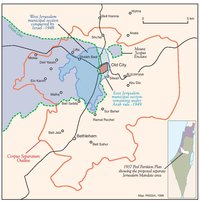
JERUSALEM AND THE CORPUS SEPARATUM PROPOSED IN 1947
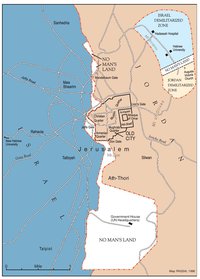
PARTITIONED JERUSALEM, 1948-1967
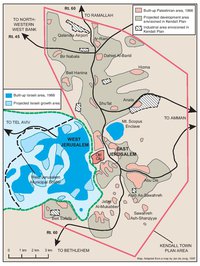
THE KENDALL TOWN SCHEME, 1966
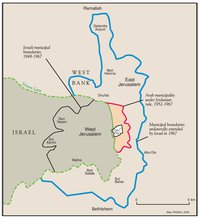
JERUSALEM AFTER THE 1967 WAR
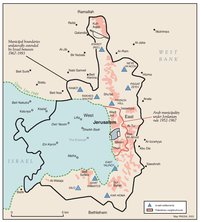
ISRAELI SETTLEMENTS AND PALESTINIAN NEIGHBORHOODS IN EAST JERUSALEM, 2000
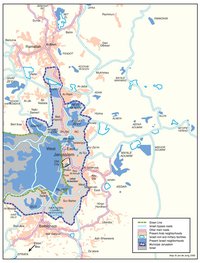
ISRAELI SETTLEMENTS AND PALESTINIAN NEIGHBORHOODS IN METROPOLITAN JERUSALEM, 2000
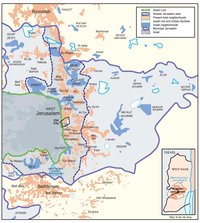
ARAB EAST JERUSALEM WITHIN ‘GREATER’ JERUSALEM, 2000
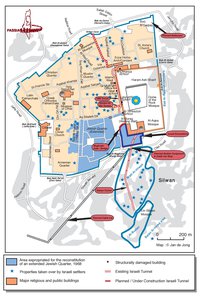
SETTLEMENT ACTIVITY IN THE OLD CITY
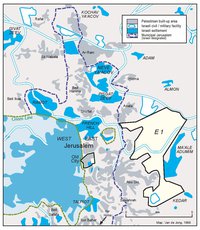
THE E-1 DEVELOPMENT PLAN
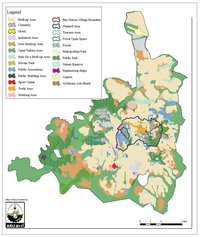
THE JERUSALEM MASTER PLAN
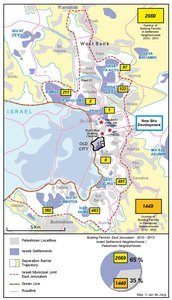
JERUSALEM TODAY (2014)


